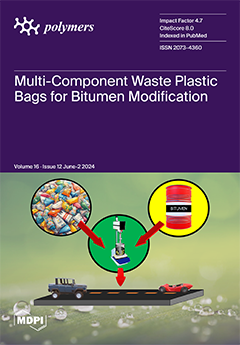A quantitative analysis of the morphology, as well as an analysis of the distribution of components and surface/interfacial properties in poly(lactic acid)(PLA) InegoTM 3251D, poly(ε-caprolactone) (PCL) Capa 6800 and nano-silica (SiO
2) Aerosil
®200 blends, was conducted in this research. The
[...] Read more.
A quantitative analysis of the morphology, as well as an analysis of the distribution of components and surface/interfacial properties in poly(lactic acid)(PLA) InegoTM 3251D, poly(ε-caprolactone) (PCL) Capa 6800 and nano-silica (SiO
2) Aerosil
®200 blends, was conducted in this research. The study aimed to improve the understanding of how PLA, PCL, and nano-SiO
2 interact, resulting in the specific morphology and surface properties of the blends. Samples were produced by varying the concentration of all three components. They were analyzed using SEM, EDS mapping, water contact angle measurements, surface free energy calculation, adhesion parameter measurements, and FTIR-ATR spectroscopy. The results showed that the addition of SiO
2 nanoparticles led to an increase in the contact angle of water, making the surface more hydrophobic. SEM images of the blends showed that increasing the PCL content reduced the size of spherical PCL elements in the blends. FTIR-ATR analysis showed that SiO
2 nanoparticles influenced the structure ordering of PLA in the blend with equal portions of PLA and PCL. In the samples with a higher PCL content, the spherical elements present in the samples with a higher PLA/PCL ratio have been reduced, indicating better interactions at the interface between PLA, PCL, and SiO
2. SEM-EDS mapping of the PLA/PCL 100/0 blend surfaces revealed the presence of SiO
2 clusters and the silicon (Si) concentration reaching up to ten times higher than the nominal concentration of SiO
2. However, with the addition of 3% SiO
2 to the blend containing PCL, the structure became more granular. Specifically, Si protrusions in the sample PLA/PCL 90/10 with 3% SiO
2 displayed 29.25% of Si, and the sample PLA/PCL 70/30 with 3% SiO
2 displayed an average of 10.61% of Si at the protrusion locations. The results confirmed the affinity of SiO
2 to be encapsulated by PCL. A better understanding of the interactions between the materials in the presented blends and the quantitative analysis of their morphology could improve the understanding of their properties and allow the optimization of their application for different purposes.
Full article






